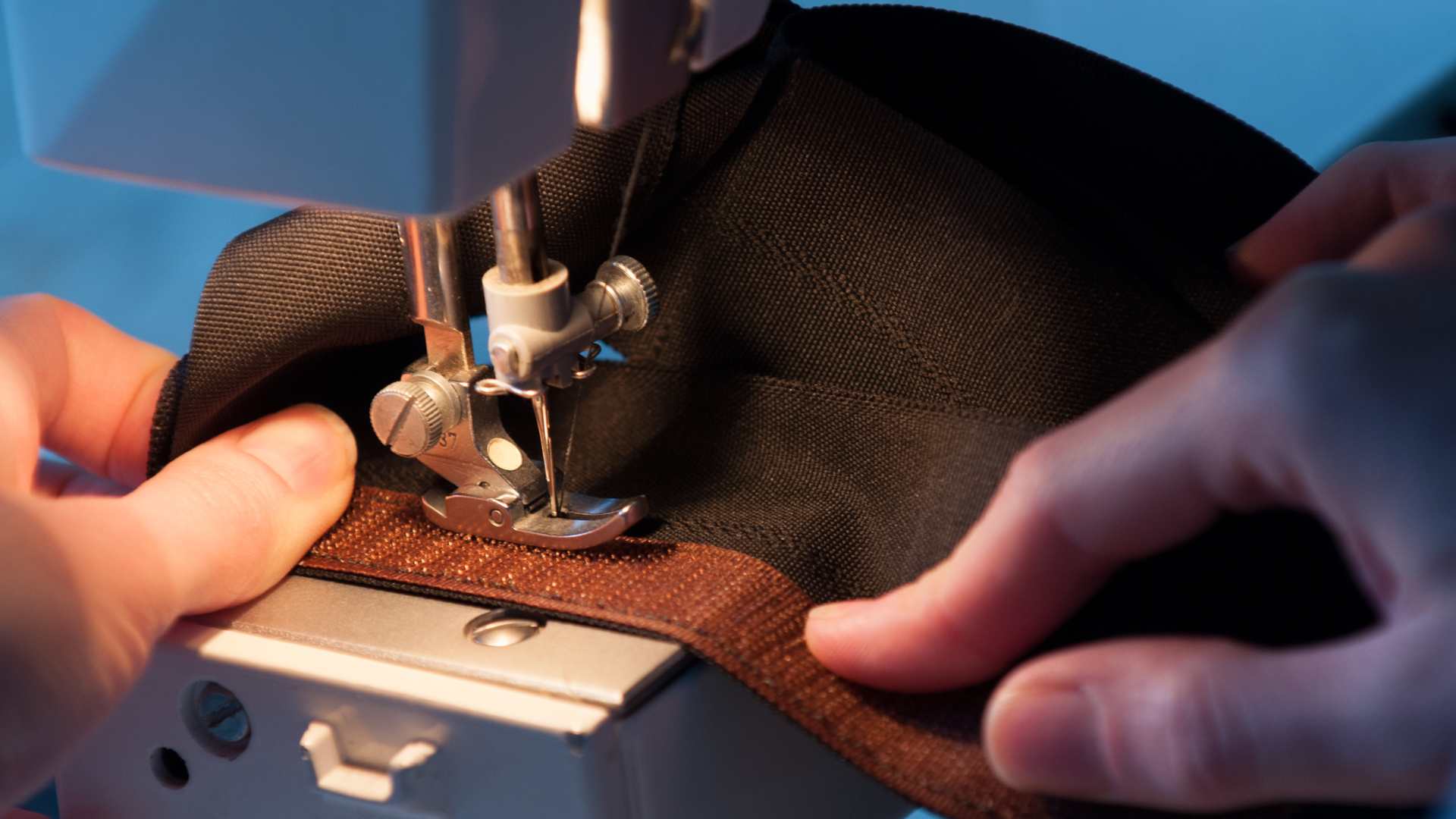Velcro provides a quick alternative to laces, buttons, snaps, and zips. Velcro is a hook-and-loop fastening mechanism that has revolutionized removable bonds between pieces of fabric, leather, rubber, and many other materials. Nylon or polyester strips that firmly grip each other have been used since the 1950s.
Velcro can be attached to the fabric by sewing. There are also various Velcro glues designed to be used with material. Fabric tape with double-sided adhesive can be used to fuse Velcro onto fabric. Other alternatives are stick-on or iron-on Velcro are trendy products that do away with glue and sewing.
Let’s have a look at the different methods to attach Velcro to fabrics:
How To Glue Velcro To Fabric
Velcro can be glued effectively to different types of textiles. The type of glue needed will depend on the application. You will not use the same glue type for thin fabric as canvas or leather. It is vital to read the instructions carefully when choosing glue. Some adhesives react differently to temperature, water, and direct sunlight.
Look for glue that is designed for use on fabric. Always test the type of glue first on a spare piece of cloth or a hidden inside seam of clothing. Once the glue is dry, you will see if it stained or stiffened the material. Have the fabric, Velcro strips, glue, and a paper towel ready on a flat surface. Apply the glue to the Velcro in the following way.
- Wash and dry the piece of cloth or clothing.
- Mark the space where the Velcro needs to go with a needlework crayon or pins.
- Cut both Velcro strips to size needed. Cut the sharp corners off, as these sometimes tend to lift and snag.
- Use the softer, loop-side of the Velcro facing towards the body so that the coarser side faces outward.
- Turn the Velcro strips upside down and apply the glue starting in the middle. Keep the edges all around glue-free to prevent the glue from leaking out onto the fabric once you press it down.
- Have the paper towel ready as you pull the tube of glue away in case it pulls strands that could mess onto the fabric.
- Let the glue dry for the period indicated on the instruction leaflet.
- Now press the glue side to the fabric. Weigh it down overnight with books or a piece of flat wood with a weight on top.
Can You Hot-Glue Velcro To Fabric?
You can use a hot gun for gluing Velcro to the fabric. Look for glue sticks that are designed to be used with textile. Not all types of fabric are ideal for using a glue gun. Polyester might melt, and fragile, delicate textiles might warp. Use a glue gun on sturdy materials like curtaining, denim, or canvas.
Consider wearing gloves (not plastic gloves) when handling the glue gun to make pressing the hot strip of Velcro down on the fabric easier. The following hints are worth considering when using hot glue with Velcro.
- Spread your fabric out on a level surface.
- Cut the Velcro strips and mark where they should be attached to the fabric.
- Put one or two rows of hot glue on the underside of the Velcro.
- Immediately press it down on the fabric.
- Weigh it down or hold for a few minutes, depending on the type of glue stick used.
Which Glues Are Best For Fixing Velcro To Fabric
Specialty glues are needed to fix Velcro to fabrics. These glues have to be waterproof so that washing and dry-cleaning don’t affect the bond to the material. You need glue that will not stain or stiffen the textile. Always consider the specific application that you need the glue for. Here are the top 5 choices of dedicated fabric glue.
Aleene’s Super Fabric Adhesive, Platinum Bond To Glue Velcro To Fabric
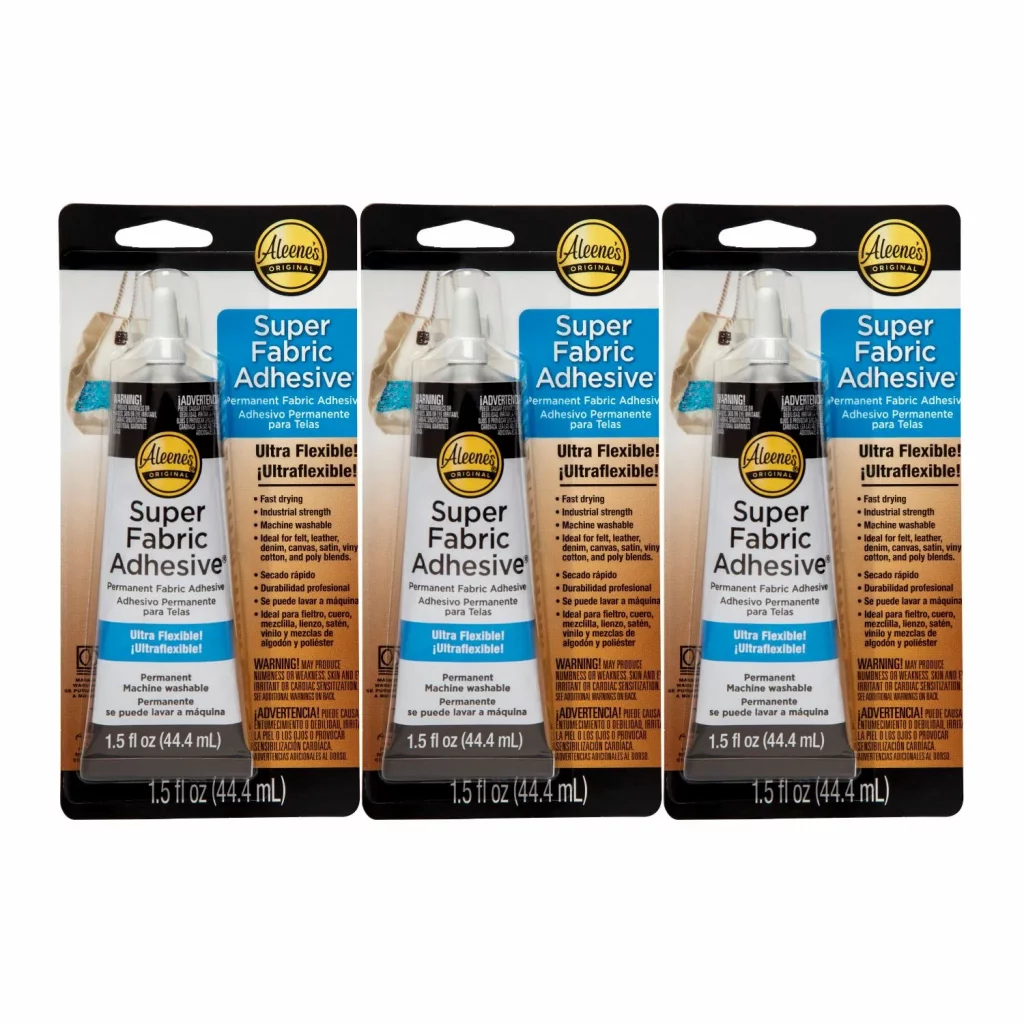
This is an industrial-strength glue designed for use with fabric. This glue will not stain the textile, and it dries fast and transparently. It is fully washable and UV resistant. Use Aleene’s Super Platinum Bond to attach Velcro to most fabric types, including felt, leather, and satin.
Beacon Fabri-Tac Permanent Adhesive For Quick Gluing Velcro To Fabric
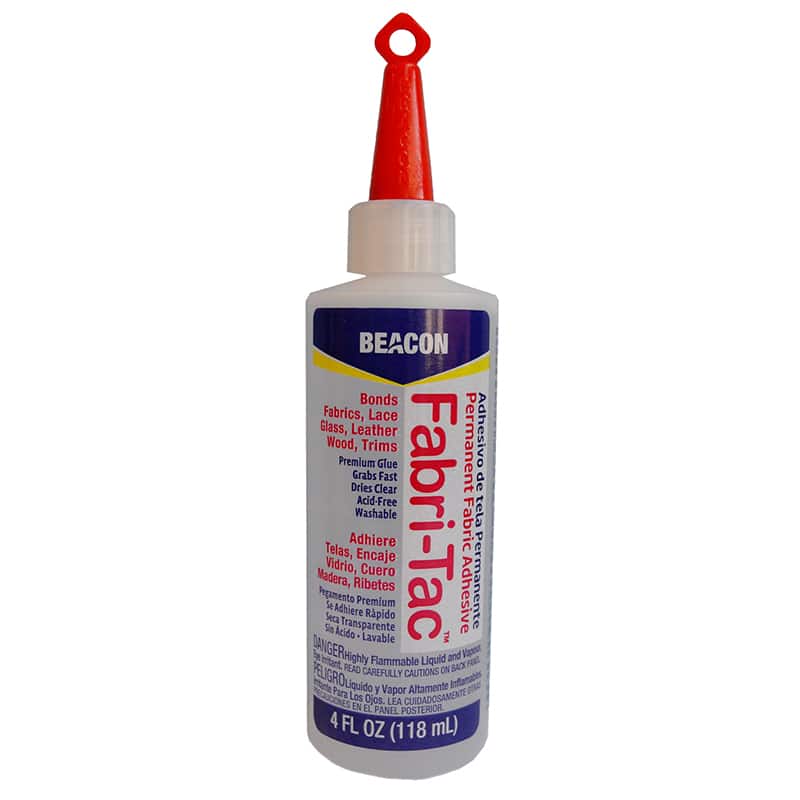
This adhesive dries really fast. It is flexible, acid-free, and will not stiffen or stain the material. Use this glue on most fabrics, including canvas, leather, felt, ribbons, wood, or glass. Beacon Fabri-Tac is available in an easy-squeeze bottle. This is an excellent product for bridal wear made of fine textiles and lace.
Aleene’s Fabric Fusion Permanent Fabric Adhesive For Light Fabrics
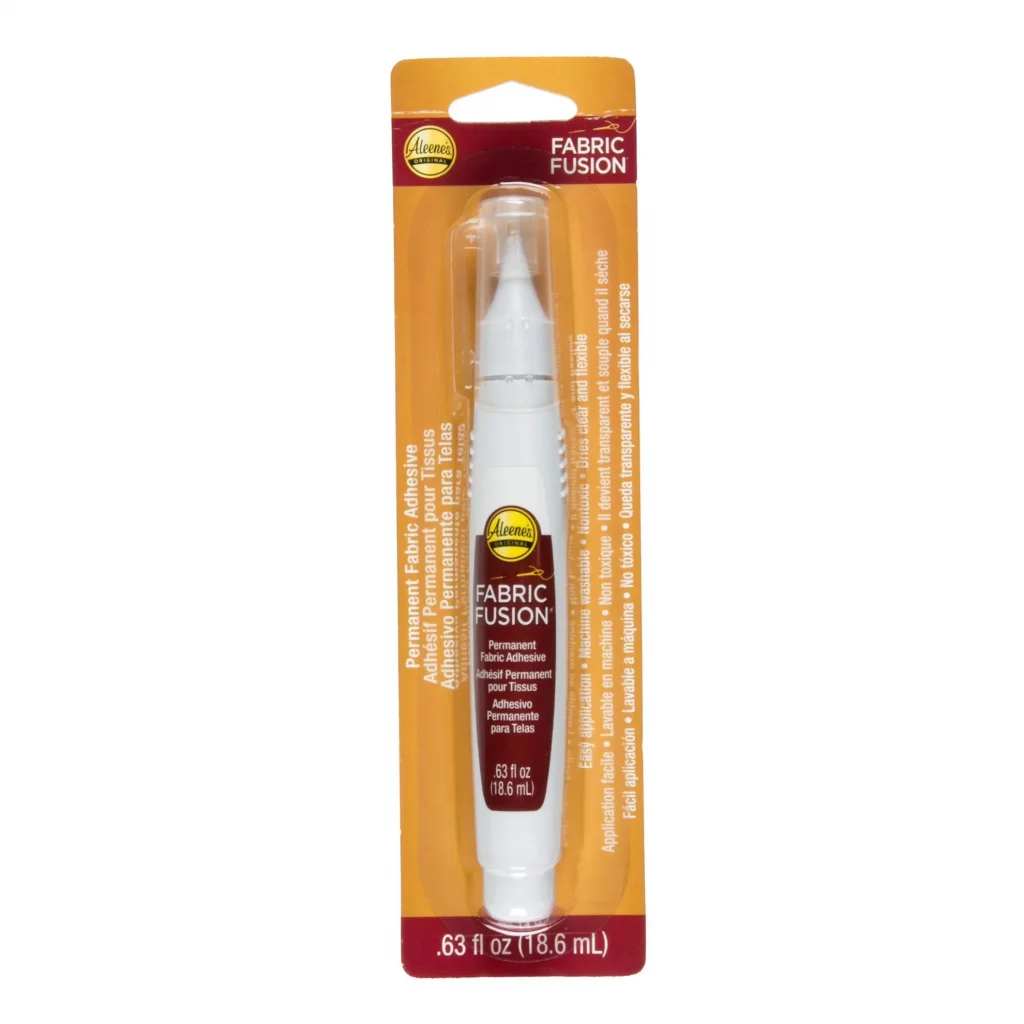
This is the glue to use when you want a no-sewing alternative for delicate fabrics. The other advantage is that this glue formula is not toxic and has no intense smell. It is very flexible and can be washed after 48 hours.
E6000 237032 Craft Adhesive For Industrial Strength Bonding Of Velcro
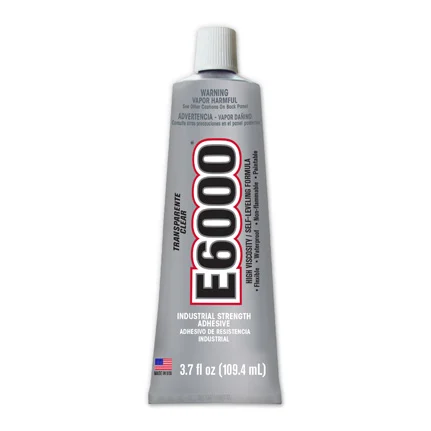
This glue is strong and effective for gluing Velcro to most fabrics, including leather. This is the best glue to attach curtains to wood or ceramic with Velcro.
E6000 Glue is fully washable and absolutely temperature resistant. Bear in mind that this glue is white when dry.
iCraft Fabric Fuse Liquid Adhesive For Precision Work
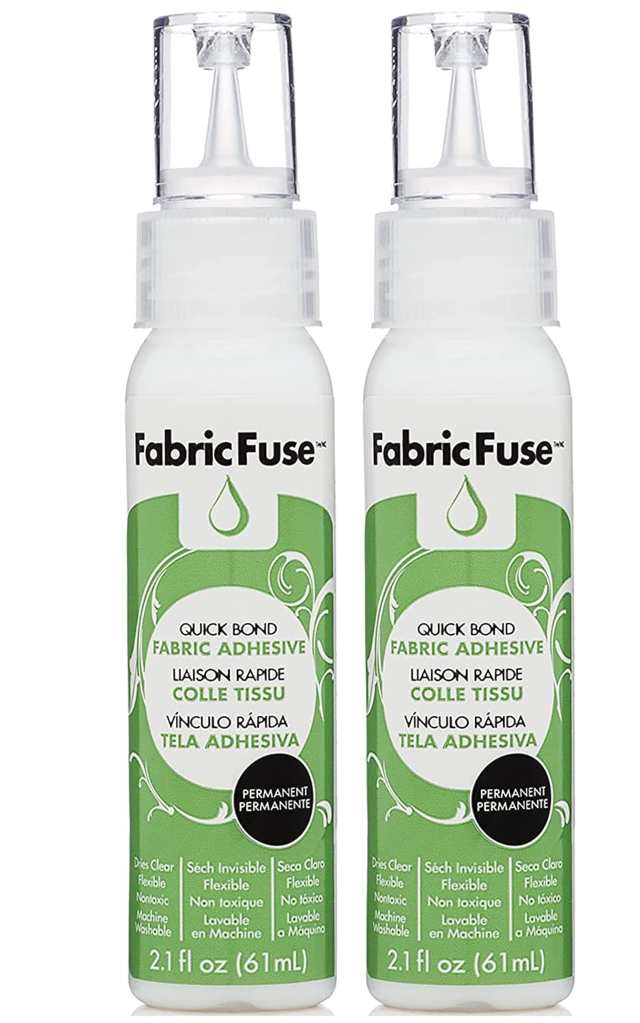
This glue is a good choice for home-décor applications. It can be used on various surfaces and types of fabrics. The bottle has a sharp tip for fine-tuning the glue placement where precision is required.
How To Use Self-Adhesive Velcro On Fabric
Velcro with a sticky back attaches to fabric without any glue or sewing. Responses are mixed as to how hard-wearing this solution is. It is a quick fix for lightweight cotton, nylon, or polyester. Do not use it on stretchy fabrics. If you use heavier fabrics like denim, iron-on Velcro products are advisable.
Choose the size and color of the Velcro strip that best suits the fabric you plan to use. Follow the steps below to attach sticky-back Velcro to the textile.
- The fabric you want to attach the Velcro to should be washed and dried.
- Cut the two Velcro strips the same size.
- Cut the corners of the Velcro for a neater finish.
- Mark where the Velcro should go on the fabric. Do not position it too close to the edge of clothing, as it could scratch your skin.
- Remove the paper strip and press the piece of Velcro firmly in place. Use the back of a spoon to massage the glue in.
- Stick the second strip down in the same way.
- Wait 24 hours before using the item.
- Only wash items with self-adhesive Velcro in cold water.
How To Use Iron-On Velcro To Attach A Patch
This is a handy method to attach badges to school uniforms or T-shirts. Use iron-on Velcro to easily prepare various patches that can be removed and used on numerous clothing items. Suitable fabric types include denim, nylon, suede, fleece, canvas, polyester, cotton, and cotton blends. Follow the steps below.
- Make sure the fabric you want to use is washed and ironed. Do not use the iron on its steam setting.
- Cut the Velcro strips to the desired size.
- Iron the area where you want to attach the Velcro strip with a pre-heated, warm iron.
- Place the Velcro strip glue side down on your fabric and cover with a piece of cloth. Do not iron directly on the surface of the Velcro.
- Iron over the strip, moving from side to side for 90 seconds. Remove the cloth and let it cool.
- Attach the other Velcro strip to the badge.
- When both the Velcro pieces are cold, you can fasten them together.
How To Use Fabric-tape To Attach Velcro
Fabric tape with its own adhesive on both sides is another option for attaching Velcro without glue, ironing, or sewing. This method works well for holding hems, smoothing down the corners of collars, or keeping pockets closed. Wash and iron the piece of clothing you want to attach the tape to and do this:
- Cut the Fabric-tape and the Velcro strips to the size you need. Cut corners round as these tend to lift with time.
- Peel the liner off and place the tape in the correct spot. Massage it down firmly and smoothly.
- Set aside for 24 hours.
- Now you can attach the Velcro strip.
- Peel the paper liner away from the attached tape and press the Velcro on top.
- Wait 24 hours before opening and closing the Velcro.
How To Sew Velcro Onto Fabric
Machine Sewing Velcro provides a permanent and durable solution when visible stitches are not an issue. Considering that Velcro can be opened and closed 8000 times, it makes sense to go for an attachment solution that will also last that long. Buy a soft and flexible Velcro; otherwise, your sewing machine might struggle to do the job.
Use a strong quality thread like polyester for sewing Velcro. Brands that perform well are Guterman, Coats, and Rasant. Use a sturdy needle such as a leather or denim needle or a size 14-16 needle. You can fit a zipper foot for easier stitching around the corners. Attach the Velcro in the following way:
- Cut the Velcro into the desired shape and size and cut corners round.
- Pin the Velcro to the fabric or use a spot of fabric glue in the center.
- Sew all along the smooth edges of the Velcro.
- Use a backstitch at the end and beginning of the stitches.
- Using a zig-zag stitch is also effective.
- For double strength applications, sew a diagonal cross over the strip of Velcro.
Hand-sewing Velcro into place is hard work but totally doable. Use a sturdy, sharp needle and good quality thread. Using a thimble is advisable. Position the starting knot between the Velcro and the fabric.
Can You Sew Stick-On Velcro To Fabric
You can secure glued or stick-on Velcro by additional sewing. It is vital to wait until the glue is completely dry. The adhesive might still cause the needle to become gummy and sticky even if the glue is dry. Durable, heavy sewing needles for use on thick fabric are advised.
To prevent the needle from gumming up, you can stick it into a bar of soap or candle wax every few stitches. A tacky needle can be cleaned with rubbing alcohol or methylated spirits. Household spray cleaners like Mr. Minn can also be helpful, but first, remove the sewing machine’s needle.
Uses & Applications For Velcro Onto Fabric
Velcro can be used on fabric in multiple ways. The applications are limitless for use on clothes and household items. Consider using Velcro to achieve the following:
- Attach badges to uniforms, sportswear, jackets, caps, and T-shirts.
- Keep hems of trousers, dresses, or skirts in place.
- Keep the corners of collars from lifting.
- Hold pockets closed without buttons.
- Use on bags and purses that tend to fall open.
- Use on backpacks for quick open and close options.
- Effectively attaches curtains
- Stop cushions from sliding around on sofas and couches.
- Keep tablecloths in place on outside tables.
- Keep pairs of gloves together.
- Use on pillowcases.
- Ideal for doll clothes and dollhouse curtains.
- A quick fix for Halloween and party costumes.
- Straps to hold yoga mats rolled up.
- Straps to hold shin-guards in place.
- Curtain tie-backs.
- Attach to bandages for people and animals.
- Lightweight curtains for caravans or trailer homes.
- Replace buttons or zips on clothing.
Can One-sided Velcro Stick To Other Fabrics?
The hook side of Velcro attaches to various soft fabrics, much like the burrs of prickly seeds stick to socks. You can use the bristly strip of Velcro without using the opposing soft Velcro strip. This could prove handy when you want to keep pillows in place on a sofa covered in a woolly fabric. Velcro hooks will attach to the following materials.
- Wool
- Nylon
- Felt (felt will become fuzzy after repeated use)
- Fleece
- Velvet
- Microfiber
How To Remove Velcro Glue From Fabric
Sometimes Velcro gets so clogged up that no attempts to clean it can make it adhere anymore. The only option is to remove the Velcro and the glue.
Citrus Adhesive Remover is safe to use on fabric. Grip the corner of the Velcro with small pliers and pull carefully. Apply small bits of adhesive remover as you progress. Test the glue on an off-cut piece of fabric first.
Acetone can be used to remove hot-glue stains. Use a cotton swab dipped in acetone and dab the glue stain from the outside to the inside. Place an old towel underneath the fabric.
Freezing fabric is sometimes an effective way to get rid of the glue. Remove as much glue as possible with a scraper or putty knife. Put the fabric or piece of clothing in the freezer and wait an hour or more. Remove the frozen glue. Use a fabric stain remover if necessary.
Conclusion
Velcro is a brilliant way to attach textile pieces to each other or to other hard surfaces. Various glues and self-adhesive options make it easy to attach Velcro to fabrics. Sewing is still one of the most permanent and secure solutions for attaching Velcro to cloth. It is easy to remove the stitched Velcro again.
Bryan E. Robinson is the former owner of TshirtGrowth. He has sold t-shirts since 2006 through dropshipping, screen printing, vinyl printing, DTG, Print on Demand, and more. Bryan has created his own t-shirt designs through Photoshop, Canva, and other platforms, as well as worked with freelancers to create many of his designs. Besides t-shirts, Bryan has over 18 years of experience in online marketing with eCommerce, B2B SaaS, B2C products, and more.

